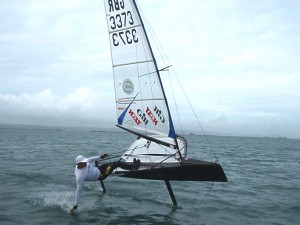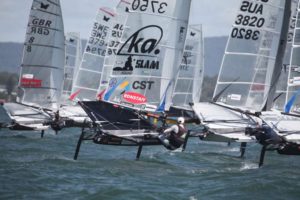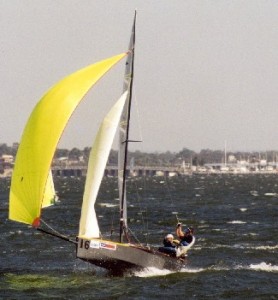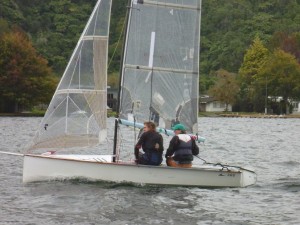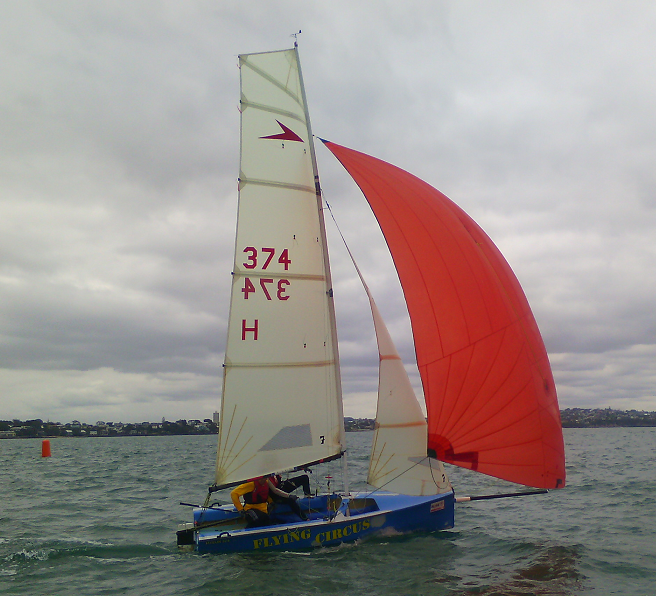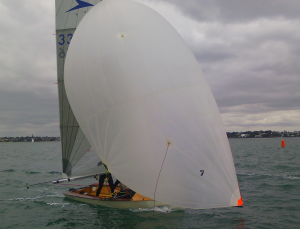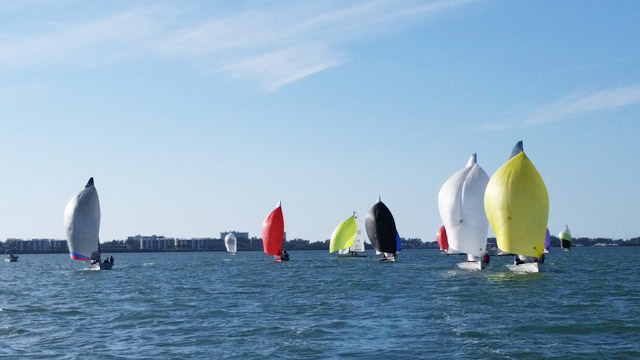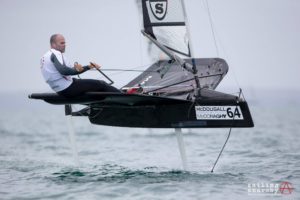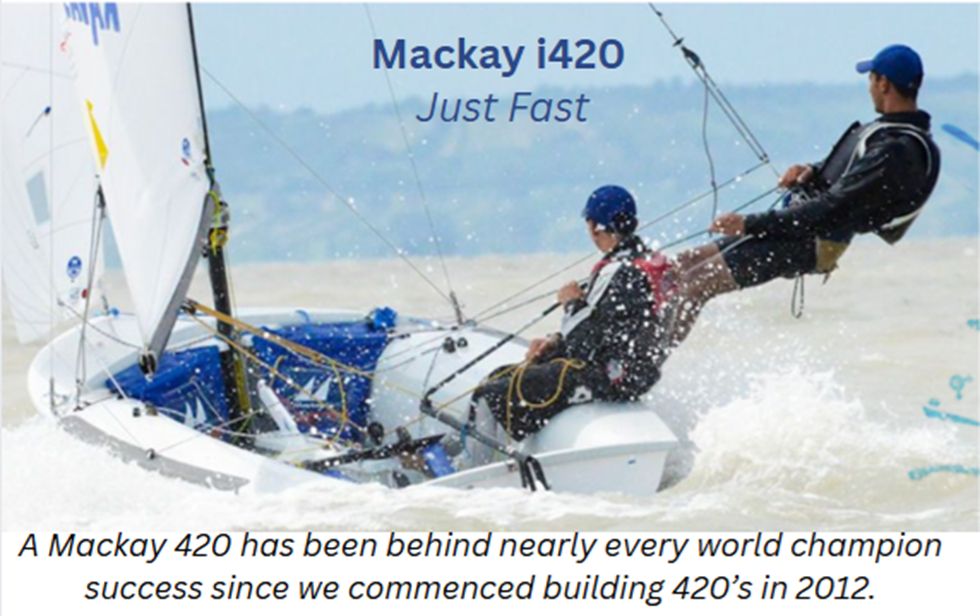In sailboat racing, there are several categories; handicap, one-design and development. Handicap allows for boats of different designs to compete against each other using a rating system to calculate final times. One-design racing uses boats of nearly identical design and configuration, and development uses a formula or box rule of different design rules to contain the ultimate product. A case can be made that one-design has the most competitive racing, however it is development classes that have driven the evolution of the sport.
The Boat: Evolution
The original International Moth was the combination of two similar boats from opposite sides of the world. In the late 1920s in Australia, Len Morris built a cat-rigged scow to sail at a resort near Melbourne. Flat bottomed and hard chined, the boat was 11 feet long and carried 80 square feet of sail area. The boat performed far beyond expectations and Morris built two more, giving birth to the Inverloch Eleven Footer.
That same year in America, Joel Van Sant built a similar boat with less sail area (72 square feet) and called it the American Moth Boat. Gaining traction, the name was changed to the International Moth Class. The Australians noticed similarities between the boats and changed the name of their class to reflect as such. However due to the economic instability in the world caused by the Great Depression, no effort was made to join these classes and they developed separately for nearly 30 years (Classic Moth Boat Association).
In the 1970s the class saw a revival and a bid to combine the US and Australian designs and class associations. This proved to have mixed results as the class continued to grow in popularity throughout Europe and Australia yet sputtered in the US.
Since the merger of the International Moth Class Association and the Australian Moth, the boat has grown and changed into the freakishly fast machine it is today. Ultra light hulls, carbon rigs, high tech sails and most importantly, hydrofoils.
Foiling for the first time in 2001 at the Moth World Championships, the foiling Moth has replaced all other variations on the international scene. In fact, since 2004, a foiling Moth has won every Moth World Championship. Equipped with a centerline foil and height control wand, Moths can foil in as little as 6 knots of breeze and hit speeds upwards of 25 knots. The Mach2 Moth is the most successful brand with 10 out of the last 11 World Championships since its launch in 2009.
Set Up and Sailing: Lift Off
Being a development class, each Moth differs slightly with set up. Once mast is stepped, the sail slips on similar to a Laser sail. The boat can be laid down on its side as to not damage the foils. This was seen a few times at the most recent Moth Worlds with the weather delays.
One of the new and most challenging parts of sailing the foiling Moth is height control. The wand senses the height of the boat off the water and adjusts the lift on the main foil to bring the height of the boat up or down. This can also be adjusted by playing with the angle of the foil on the rudder blade. The altitude of the boat is initially adjusted by the trim of the boat, using the rudder foil for fine tune.
Once out of the water, or flying, the boat must be controlled using body weight adjustments and the rudder foil. Sitting too far back will cause the boat to continually climb until it launches out of the water. Sail trim also contributes greatly to control of the boat. Because of the huge amount of apparent wind created by foiling at high speeds, controlling the power in the sail using vang and mainsheet is key. More detailed information on getting the boat airborne and responding to different conditions can be found here (http://www.teknologika.com/mothblog/wp-content/uploads/Guides/sailing_the_bladerider.pdf).
Class Association: Growing
The International Moth Class Association has had wildly successful World Championships the past few years. They have drawn many of the biggest names in speed sailing to locations such as the 2015 Worlds in Sorrento, Australia. With 79 boats in the Gold Fleet and 76 in Silver, this event was by far one of the most popular, from a numbers standpoint, of any one-design class currently. The class is still gaining popularity in the states and a large cohesive body is still in its fledgling state with a Facebook group but no formal website.
Why Sail?
This should be a no brainer. There is no more exciting and accessible boat in the world at the moment than the foiling Moth. A big price tag may scare off most weekend warriors, and by no means is it a beginner boat, but for current/former competitive sailors with some extra money, there is no better purchase.
Learn more about the Moth: http://www.moth-sailing.org
Blog
Notes From New Zealand: The Javelin Skiff
Not Your Average Weekend Warrior: A look at the Javelin Skiff
By Airwaves writer Sara Morgan Watters
The Javelin Skiff is not your average double handed dinghy. At 14 feet this high performance, single trapeze skiff is far from a boat that will get you out on the water for some casual weekend racing. Expect to have a high intensity sail if the breeze is anything but light. Capable of exceeding speeds of 22 knots off the wind with the gennaker up, this class is not where you’d expect to find your average weekend warrior.
Before I attended the Javelin Nationals this past weekend at Takapuna Boating Club in Auckland, NZ most of my time “sailing” the Javelin during weekend club series had actually been spent in the water swimming. The most hours I racked up in the skiff was over this weekend of racing where I was thoroughly impressed with my competitors knowledge of the boat and how to make it to go fast – really fast.
With a few boats trickling in from different regions of New Zealand to compete in the event, it became clear to me that these were a group of people who, like the motto of the Javelin class, like to get out on the water to go fast, have fun and do it in an affordable boat. For this group, the Javelin provided them with more than just a boat to do weekend club series events.
Choosing my words carefully – I observed that my competitors were of a slightly older generation, which further contributed to the impression they left on me as we zoomed to the leeward marks in 20 knots of breeze on the first day of racing. But the impressiveness of the Javelin fleet didn’t start on the water. Most of the sailors have been sailing the boat for a long time and know the technicalities to really make them hum.
Being a Restricted Development Class, loose class rules allow sailors the freedom to experiment when building or modifying a boat. Surely enough this has allowed the class to evolve as individuals find new and innovative ways of making the boat go faster. Modifications range from hulls, foils and control systems (including a fuse release for the gennaker), to self-tacking jibs to elaborate mast bend control systems.
As the class website says, ‘the ability to “try something out” has seen some of yachting’s biggest names design Javelin hulls. IACC designers Bruce Farr, and Ian Murray being notable examples. It is also common for owners to build their own designs”.
With no fear of chopping and changing parts of the boat, the race begins long before the first warning signal. The “do it yourself” attitude not only helps keep participants of the class innovative, with the latest designs being developed at home in the garage, but it also keeps the boat affordable. This DIY attitude should come as no surprise as Kiwis pride themselves on taking initiative.
At Nationals having a good boat set up was just as much a part of the winning formula as making good decisions on the water. With former 470 World Champions and Europe dinghy world medallists, the competitors were by no means amateur racers. Only the winners of the event, who put up a perfect picket fence, demonstrated complete mastery of the boat as well as good tactical decision making. However, even then they weren’t always leading around the course, as the other competitors made them earn their positions.
Beyond this pinnacle event in Javelin sailing, others around New Zealand and Australia have enjoyed what the Javelin offers and it is common to find the Javelin on the starting line at different Club events around New Zealand. Where the important aspects of sailing, like boat design and tuning, meet a fun and fast boat on the water, there is something for everyone in the Javelin. No matter what your level or experience you’ll be able to take something away with you.
To learn more about the Javelin class, visit here: http://www.javelins.org/
ICSA 2015 Team Racing Season Preview

As always, New England features great depth in team racing. The big story in NEISA is Yale’s potential for a 3 peat at Nationals. Before the Bulldogs even think about that they will have to advance through their Conference Championship which is easier said then done. Most New England teams are short on practice in mid April so its anyone’s guess who will be ready with their A game. There are 13 teams profiled here with as many as 15 who might be in the mix for a spot at Conference Championships which has only 12 berths.
Photo by Rob Migliaccio
Yale-The Bulldogs are returning many players from the 12-13 and 13-14 National Championship winning squads. seniors Kate Gaumond and Graham Landy, junior Charlotte Belling and sophomore Ian Barrows are all back to try and three peat. With the loss of Chris Segerblom, Will Feldman, Eugenia Custo-Greig and team race phenom crew Marlena Fauer, the Bulldogs will have to look for skippers Mitchell Kiss ’17 and Malcolm Lamphere ’18 and crews Clara Robertson ’17 and Meredith MeGarry ’17 to try and fill that void. This team is deep and will have a great practice squad to scrimmage. This includes women’s All-American skipper Morgan Kiss.
BC– The Eagles finished a solid 4th at last years Team Race Nationals. They are returning ALL of their skippers! Seniors Katherine Wysocki and Beth Barnard in the front of the boat and Will Bailey on the helm with junior skippers Erika Reineke and Raul Rios have a ton of experience. This BC team is also deep and create great in house races as well. With a flock of very good crews at their disposal, this team will not skip a beat. Watch for Alex Palfrey, Allison Ferraris and Katherine Downey to see some action. And when the breeze is on look for Chris Dwyer and Dominic Bove be the difference makers. This team will contend for the national championship.
RW-The Hawks are the third team here that have all players returning. They had a difficult nationals but that was an anomaly. This team can get the job done and with another year under their belts they are, in my opinion, the favorite to repeat at the NE team race champs. Senior crews Wendy Reuss and Abby Preston along with senior skippers Will MacDonald and Henry Vogel will want to make the most out of their last year. Juniors Conner Corgard (sk) and Breanne Baldino (cr) will need to make the most of this opportunity. The Hawks have a fairly young 2nd squad and the upper classmen will need to get this group up to speed quick to make the most out of practice.
Tufts-The Jumbos might have the biggest loss here from graduation losing the skipper-crew pairing of Will Haeger and Paula Grasberger. These guys were a strong combo together. I don’t think Will ever needed a heavy! They were that good together. Add to that the loss of David Liebenberg and the Jumbos will be way behind where they were at this point last year. Senior Alejandro Ruiz-Ramon will most likely be flanked by skippers Dan Nickerson and Scott Barbano. A strong team of crews including Caroline Atwood and, Sam Madden and Janie Maffeo will be a strong backbone of the is team. Don’t get me wrong, even with the loss of last years seniors, this team will be well coached and ready.
Dartmouth-Here is another team that lost some great sailors from graduation. Looking to step in for Matt Wefer and Avery Plogh will be Women’s Sailor of the Year Deirdre Lambert and possibly Nathanial Greason as crew. Senior Scott Houck and Colin Murphy will be the logical skippers to support Lambert. Crews Hope Wilson and Sophie Kerr will be instrumental in this effort to reach the nationals.
Harvard – The Drumm brothers Brian and Michael are returning as well as skippers Andrew Mollerous and Graham Slattery. With Harvard hosting the 2015 Fowle Trophy, this team could be the wild card. But they won’t count on that. Mike and Bern will have them sailing better than ever this spring.
Brown-Pearson Potts and Lucas Adams are going to have to find a way to replace All Americans Tyler Rice and Judge Ryan. Big loss there. Add to that with the loss of All American crew Louisa Chafee and the Bears will need to have crews Jessica O’Dell and Lydia Whiteford really step up their game. Skippers Nathan Almann and James Barry will be vying for that third spot as will crews Marina Cano and Ragna Eide. The bears are potentially good enough to steal a spot but will have to work hard to gel as a tight team come New Englands.
UVM– All three skippers are returning for their senior year. Michael Zonnenberg is the clear leader of this team along with skippers Nate Jermain and Michael Booker and senior crew Bridget Murphy. The Catamounts finished pretty far outside the final four at last years qualifiers but this is a veteran group and should greatly improve upon that finish. Look for underclassman crews Megan Mackinnon and Lauren Jones along with Freshman Lilly Salveson to really improve the skill level of the Catamounts. BUT! The cold and frozen Lake Champlain will delay early season practice. This could hurt big time.
Bowdoin-The Polar Bears are another team where location could be an early season practice issue. But, Bowdoin does have some talent and coach Frank is doing a great job recruiting. They are returning Skippers Jack McGuire and Michael Croteau and all of their crews: Charlotte Williamson, Julia Rew and Mimi Paz. Freshman Harrison Hawk is the new guy at Bowdoin but brings with him some great team race experience finishing second at last years High School Nationals. This could be the most improved team from last year.
MIT– After a standout fall season, which saw the Engineers score numerous top 5 results, this spring might be more of a learning and rebuilding year for MIT in team racing. They have 3 strong younger drivers in Alexander Stewart, David Larson, and Ty Ingram that are supported by crews Lisa Sukharev-Chuyan, Jordan Ladd, Kyle Joba-Woodruff, Paige Omura, and Greta Farrell. Don’t count them out! MIT has an all star coaching staff with multi time Team Race World Champion Matt Lindblad, all around great sailor and coach Mike Kalin, and College Sailing Legend Fran Charles. These guys could be very good later in the season.
Coast Guard– The Bears have all of our returners from last year who started to learn the game and see some results. 1st at the Admiral Moore Trophy last year- the first time CGA has won a team race interconference in over a decade. Starters will be Avery Fanning, Nikole Barnes, and Dylan Finneran. They’ll be taking advantage of the strong “B-level” circuit sailing the Jackson, Geiger, Admiral Moore, Barque Eagle, and Fowle and looking to take some races away from the big dogs here and there.
Connecticut College– The Camels will be tested this year, graduating All New England and 4 year starter Kevin Martland and IG Schottlander. Returning skippers Jordan Bothwick and Bryce Kopp will work hard to help freshman Hugh McGullivary and senior Ellis Tonissi get up to Speed. All New England crew Lea Bushnell and senior Kim Bolick will keep the Skippers informed and lead a talented group of crews lead by Toti Allen, Ben Meyers and Eliza Gary. The Camels will be tough in each race but lack experience to make a run to the top of the New England list.
BU– The loss of last year’s team captain, Cam Fraser is definitely a hit for the BUDS, but with several other sailors returning for last year, the BUDS team racing team should improve relative to last season. A strong freshman class has certainly helped the BUDS, especially in the crew department. Connor Astwood finished 5th in B division at the New England Champs his freshman year, and had some strong events last fall. He will be the leader of the BUDS team race team. Freshman skipper Ravi Parent had some great F-18 results in high school, and finished 4th at the youth worlds in multihulls in 2013. He does not have tons of double handed dinghy experience, but may be contributing on the team racing team as the season progresses.
MAISA
The Mid Atlantic Conference is notoriously strong at the top with at least 1 team in the final 4 at Nationals every year. They may not be quite as deep as NEISA but their teams are well coached and looking to turn heads in May. Like NEISA, 4 will advance through their Conference Championships to Nationals.
Georgetown– Hoyas are returning all of their starters from the 2014 season and looking to improve on their 5th place finish at last year’s nationals. With the same players, Georgetown is clearly the early favorite in MAISA looking to tighten up their game from last year.
Navy– The Goats are returning 2 of their 3 starting skippers from last season, led by Mary Hall and with the addition of Patrick Snow, the Midshipmen are looking to step it up a notch from last year’s 6th place Nationals finish.
Fordham– The Rams are young, talented, and wily and with newly appointed coach Johnny Norfleet, they should be a pretty solid contender in MAISA.
St. Mary’s– Following a very impressive 2nd place finish at nationals last season, the Seahawks have unfortunately graduated all three of their starting skippers. Adam and Bill shine in the team race arena however, and they’ll have their squad competition ready as the season moves on.
Old Dominion– Led by Esteban Forrer, the Monarchs may have their hands full tightening up their squad for championship season. A talented coaching staff however will ensure that they take wins off the heavy hitters in MAISA in the process of making a name for themselves.
HWS– Eddie Cox and Elliot Morrill are expected to lead a young team. With some strong talent and the leadership of Coach Scott Ikle, these guys should turn some heads.
Cornell– Another MAISA squad who could take some wins off of the stronger teams. Matt Schofield and Connor Kelter are young guns who, with the help of Coach Brian, could have an impact on MAISA.
SUNY– This squad has some talent but youth and inexperience may prove hard to overcome. First year team race Coach Zach Runcey may have his hands full but this squad is fast.
George Washington– Certainly an up-and-comer in MAISA and could take some wins off the big names under the right conditions. Coach John Pierce knows his team racing and will certainly have these guys executing some good plays this spring.
SAISA
While SAISA has very solid participation in Fleet Racing it has unfortunately struggled to create consistent participation in team racing. The story in the South Atlantic Conference is which 2 of the 3 strong varsity teams will advance to Nationals
Charleston– The Charleston Cougars bring back all of their team members from last spring and should be the team to beat in the Southeast. They just missed out on the round of 8 at Nationals last year and will look to better that result. There starting drivers are senior Nick Johnston and juniors Ryan Davidson and Jake Reynolds. Crews will be senior Alicia Blumenthal and juniors Rebekah Schiff and Emily Stuart.
USF– The South Florida Bulls will be returning several key team members from last spring including the senior duo of Christopher Stocke and Ali Yarbrough. USF with Chris at the helm nearly won Match Race Nationals this fall and will look to take that momentum into the spring team racing season.
Eckerd– The Tritons will continue to develop their young talent and make an appearance in NEISA for the highly contested Marchiando Team Race at MIT. Coaches Kevin and Zach believe in the process of learning team racing and will show steady improvement throughout the year.
Other teams who may get in the mix could include U Miami and the Jacksonville Dolphins.
PCCSC
Stanford– The Cardinal loses some big team depth graduating 11 seniors but return drivers Kieran Chung and Hans Henken who contributed to last years 3rd place finish at Nationals. Crews are still coming together but senior All American Haley Kirk is sure to be in the mix. There are a number of talented younger sailors vying for a starting spot and only time will tell who gets the nod. Once again, Stanford will travel east to compete in ICSA’s top events and should be a strong contender near the top. They will easily advance to Nationals but the question always remains, can they put it together at the big event?
Santa Barbara- The Gauchos continue to attract good recruits and are working hard this year to step up their team racing game. Returning starters Stephen Long and Ian Stokes will likely be joined by one of their talented freshmen possibly Kristopher Swanson, Sterling Henken, or Simone Staff. I would definitely expect Ginger Luckey and Madisson Thomas to contribute as crews. If the Gauchos can master their plays they will definitely take wins off some very good teams. At this point, they are probably the favorites to take the 2nd PCCSC birth at Nationals
Hawaii– The Rainbows are coming off a strong Fall PCC victory and will challenge the top teams in the west. They lack some team racing depth but have the boatspeed to get around the course. The Rainbows benefit from 2 experienced full time coaches and will certainly improve throughout the year.
Other teams to watch in the PCCSC include Cal Maritime who have a strong team racing coach to work with, USC, and Long Beach.
NWICSA
In the Northwest both Western Washington and University of Washington are always near the top of their conference. They will fight it out for a birth at the big dance but I give the early edge to Western Washington based off stronger fleet race results this fall.
MCSA
Top teams in the Midwest continue to mix it up with the best in college sailing. Like PCCSC and SAISA they get 2 births to Nationals based off conference population.
Wisconsin– The Badgers are lead by senior George Kutschenreuter, a legitimate contender in any ICSA event. Unfortunately they don’t return either of their other 2 drivers from 2014. Senior Conner Trepton is a likely starter. Wisco sailed 7 crews at Nationals last year and many others this fall so it’s unclear who will start for them in the front of the boat. These guys are definitely a favorite to win their Conference Championship and a spot at Nationals.
Michigan– Like Wisconsin, Michigan only returns 1 driver from last year but senior Alex Ramos has scored top 5 interconference results and can compete with anyone in college sailing. The Wolverines finished tied for 1st in the Big Ten Team Race this fall with drivers Thomas Etheridge and Christopher Cyr. They also have sailed a large number of different crews with these drivers this fall. Michigan is likely to take one of MCSA’s Nationals births and is probably the only team capable of challenging Wisconsin.
Northwestern– The Wildcats finished 3rd at the Big Ten Team Race and made the trip out west for the Rose Bowl. They will mix it with the top dogs in MCSA this spring.
Minnesota– Emily Oltrogge and Alison Kent are the Gopher’s Coed and Women’s starting drivers. They have better fleet race results then Northwestern but it’s unclear how they’ll stack up in team racing.
SEISA
Texas A&M Galveston seem to be the team to beat in the south and likely to take the conference’s one birth to Nationals. University of West Florida and Texas A&M have shown some good results this fall and may challenge Galveston for a spot at the big dance.
______________________________________________________
About Sail1Design
Sail1Design is a grassroots organization, by sailors for sailors, dedicated to the one-design, youth, high school, college, and one-design sailing communities. Born in 2007, Sail1Design has grown considerably, and reaches out to all sailors wishing to enjoy and learn more about our sport. We have three main areas of business:
SAILING/MARINE INDUSTRY CAREER CENTER & JOB BOARD
We offer sailing’s #1 Career Center and Job Board, always chock full of incredible sailing job opportunities. Our comprehensive career center also offers job seekers the ability to create their own web page, highlighting their experience and posting their resume. Likewise, employers can search our resume database to find the right match for that open position. Sail1Design is proud also to be the official job board of the Intercollegiate Sailing Association (ICSA), and the US High School Sailing Association (ISSA).
MARKETPLACE & PROFESSIONAL BROKERAGE
Unique to the industry, Sail1Design hosts and manages an active private, by-owner marketplace, focusing on performance and one-design sailboats & gear. For all boats under 25′, our ads are free. What makes us different is that we also provide, side-by-side, professional brokerage services as well. We have had great success helping our sailing clients market and sell their boats, using our powerful client base, social media, and the brokerage industries multiple listing service to ensure your boat gets noticed.
AIRWAVES NEWS & CALENDAR
S1D also hosts Airwaves, an interactive, user fed Sailing Calendar and informative Sailing News, Articles, tips, & more. Airwaves has developed a great niche in the sailing publication world, and now boasts a seven-member staff of dedicated sailors, all contributing to our varied content.
Peter Beardsley & Danny Pletsch Win Viper 640 Sarasota Winter Circuit
February 9, 2015
Amidst snowstorms and freezing rain in the northeast U.S., 15 Viper 640 sport boat teams made the trip south to sail in sunny conditions with green water. This was the final installment of the three-part Viper 640 Sarasota (FL) Winter Circuit that included weekend regattas in December and January. The Race Committee at Sarasota Sailing Squadron squeezed in 9 races in conditions that never reached more than 10 knots, with large shifts, managing the seemingly impossible as fleets at other one design regattas in Tampa and St. Petersburg a few miles north struggled to get in 3 races in similar conditions.
The hybrid Blackout Panda team of Peter Beardsley, Rachel Beardsley, and Danny Pletsch improved on their January performance, winning 6 races and scoring no worse than a second to win the event by 15 points over the Amthor-Eberwine team from Hampton YC. Blackout Panda Larchmont Yacht Club stablemates Dragon Fire finished strong with a 3-3 to leapfrog Peter Denton’s Newport team by a point for third place.
The event also marked the conclusion of the Sarasota Winter Circuit, with an outstanding 28 races completed over 3 events in December, January and February. The circuit scored each race individually, with teams dropping their worst 30%. Blackout Panda discarded all but one of their DNCs from December to edge the Amthor-Eberwine team by five points for the circuit title, with Peter Denton’s Toriffic team finishing third, just ahead of event chair Travis Yates and his Sidewinder team, and Executive Committee member Steve Chapman from Ottawa, Ontario in fifth. The teams now prepare for two Miami March events, with the EFG Winter Cup March 1-2, and the EFG Viper 640 Pan-American Championship at Bacardi Miami Sailing Week sponsored by EFG International March 5-7 with a record 37 teams registered.
Results
http://www.regattanetwork.com/clubmgmt/applet_regatta_results.php?regatta_id=9200
Contact: Viper 640 Class Administrator Ed “Buttons” Padin, [email protected]
Profiles in Pro Sailing: Andy Horton
Editors Note- As part of our mission to support the sailing community, Sail1Design is pleased to unveil our new series, Profiles in Pro Sailing. This series is designed to give our community thoughts, ideas, tips, and reflections on how some of the best in the industry made it to where they are today. We hope these articles are informative, and maybe even inspirational. As always, we invite comments and feedback.
By Airwaves writer Tyler Colvin
I race sailboats for a living. There isn’t a single sailor who hasn’t dreamt of uttering these words at one point in his or her lifetime. For a small sport, there are an even smaller number who make a living solely from sailing regattas year round. In the professional sailing conversation, names such as Ainslie (GBR), Coutts (NZL) and Spithill (AUS) come up. Enter Andy Horton (USA). Professional sailor.
Andy grew up in upstate Vermont and learned to sail on Lake Champlain and Lake George (NY). Not exactly a hotbed for the next who’s who of Olympic hopefuls, the Northeast often features water that is frozen almost as much as it is not. “First time I ever dreamed about it was before I was 10 years old,” recalls Horton, “(at that time) it was rare for people to just get paid to go sailing. I would read every article in Sailing World and just try to learn and absorb as much as I could from anyone I could. It wasn’t until I got to high school that the America’s Cup was a place where people could really make a good living, but the path wasn’t clear.”
Horton attended Tabor Academy in Marion, Massachusetts and went on to Hobart College in the Finger Lakes region of New York State. At Hobart, Horton was a three-time All-American, and the thoughts of making a living on the water started to form. It was after graduation that he began his Olympic Soling campaign. “I lived out of the back of my car, sailed as much as possible and tried to meet as many people as possible.” Said Horton. “ (It was) in college I started to think that maybe I could do this full time.”
The year was 1999. Freshly out of school with an Olympic Campaign underway, Horton was beginning to figure out the game. “(In) 99/2000 we had 38 Farr 40s at Key West Race week, there were a ton of opportunities. This was my dream and it was working.” With the economy still strong, there were a glut of owners with a wad of cash and empty boats. “I tried to learn as much as I could and tried to sail with as many people as I could. In the beginning of your career, learning from them (is crucial).”
One of the people he met was none other than Ed Baird. “I met Ed Baird and jumped on the World Match Racing Tour with him. (In 2003 and 2004) We won back to back World Championships, did a lot of awesome sailing, and tried to absorb as much as I could.” In addition to his match racing, Horton also still had his Olympic campaign. However, with the discontinuation of the Soling class after the 2000 Olympics, his focus switched to the Star Class where he would podium numerous times, including a 1st at the Miami Olympic Classes Regatta in 2005 and a 2nd in 2006.
Around this time Horton was asked to try out for the Italian America’s Cup team, Luna Rossa. “My senior year of college I gave myself until age 30 to try and make (professional sailing) this work. I was at my America’s Cup tryout on my 30th birthday, having a beer in Spain saying, “We’ll see.” Luna Rossa went on to lose the Challenger Series that cycle to Emirates Team New Zealand, but this wasn’t the end of the road for Horton.
Fast forward to 2015. Based out of Vermont with a family, Horton continues to sail at a high level. At events, his day starts before sunrise and ends well after dark, getting weather forecasts, regatta information, racing, boat work, and debriefing the crew. When not competing all over the world, he spends his time at home getting caught up on emails, setting up team travel and staying in shape. Recently he has forayed into the world of foiling Moths. He had just gotten back from Moth Worlds when this interview was conducted and the excitement was palpable through the phone.
TC: What is your favorite class and why?
AH: Moths. Just got back from Moth Worlds. I sailed one for the first time a year ago, and with other people for the first time about two weeks ago. It was the coolest experience I’ve had in 20 years of sailing. I’ve sailed a lot of cool boats and this was by far the coolest.”
Even professional sailors still get giddy.
Despite all the successes, Horton doesn’t hesitate to downplay his role in the programs he has been involved with. “Its amazing thing and I’m lucky to be able to do what I do and meet all these different people. It is amazing to see how people from different walks of life approach the same age old problem, how do we make the boat go fast. It puts a smile on my face when I can think of all the people I’ve had the privilege to meet and sail with.” It is this approach that has gotten him to where he is today and when asked about it, his top two suggestions were along the same lines.
Number 1, be humble. No one likes to work with people who aren’t. You would be surprised at how many of these relationships you revisit year after year.
Number 2, do any job, do every job, and do it well. Move every sail and sponge every bilge. Never let anyone work harder than you work. Be open minded.
From FJs to AC72s, the dream of a 10-year-old Vermonter is being played out almost 30 years later around the world. It is not without challenges though. “The most challenging part has been being an “independent contractor”. You don’t know where the money will come from next. When you’re young, keeping expenses and overhead to a minimum makes it possible.” In addition he adds, “Time management is another stumbling block…knowing where to go, what to do, and who to turn down. Picking what direction to go can be the most difficult. Getting to know the community is pretty important if you want to make it in the industry.”
It is no lack of hard work, humility and the drive to live his dream that allows Andy Horton to say, “I race sailboats for a living.”
Using Weather to Dominate the Competition, Part 3: Precipitation
By Airwaves writer Eric Tobias
(for part 1: https://www.sail1design.com/using-weather-dominate-competition/)
(for part 2: https://www.sail1design.com/using-weather-dominate-competition-part-2-sea-breeze/)
Precipitation
Precipitation is an important factor to consider as a sailor. Rain doesn’t only mean that we might have to change gear or be ready to get wet; it could also signal changes in wind or act as a preview of the severe weather to come. With good knowledge of exactly when the weather is coming, you can get the most sailing time out of your practice or regatta.
It really grinds my gears when people rely on precipitation percentages to assume whether it will rain or not. The percentages described are your weatherman’s attempt to communicate uncertainty usually 12 hours to a few days in advance. There’s a reason why meteorologists don’t claim it will rain for sure from 6:30 – 7:00 and won’t rain from 7:00 on, because if it rained at 7:05, people would get all wet and upset. So for a rain forecast, percentages will have to do. A 50% chance of rain represents the highest uncertainty, and if you see a 90-100% chance of rain, you can be pretty darn sure it’s going to rain. However, with a look at a surface map and a good radar app, you can get along without these percentages all together.
Radar is the single most useful tool for predicting precipitation. Every sailor should utilize weather radar. If you don’t already have a radar app on your smartphone, you need to download one immediately. Go ahead, I’ll wait. I prefer to use an app called MyRadar because it’s simple and it’s free. When I’m coaching or sailing, and some weather is on the horizon, I constantly monitor the weather radar (I have a waterproof case on my phone; every sailor needs one of these also). This way I can know precisely when the rain or storm is coming, allowing for maximum time on the water without jeopardizing safety. When you always have a radar app in your pocket, you no longer need to rely on percentages to guess about the rain.
A cold front extending from Wisconsin to Texas brings severe thunderstorms and heavy precipitation.
One tip for using weather radar is to look at the color bar scale in relation to radar reflectivity because it’s not always consistent for each website or app. Where you might see a yellow “blob” on one website, it might only be green on another. Radar reflectivity is measured in decibels (dBZ) and it basically corresponds to the intensity of the precipitation. Here’s a brief guide to dBZ numbers and the weather that may accompany them: For 25 dBZ and under (normally green), it means mist to light rain. From 30-40 dBZ (normally dark green or yellow) means moderate rain. From 45-55 dBZ means heavy rain or light hail (normally red or dark red). From 60 dBZ and up (normally very dark red to pink to white), you better get the sails down and watch out, because that’s a severe storm producing extreme rain or large hail.
Summary
A lot more variables go into weather forecasting than the ones I’ve included here, and they extend up through multiple levels of the atmosphere. I’ve provided a guide and some tips that are more applicable to sailors, and hopefully you can use some these tools to dominate your competition at your next regatta. Now that you know about surface maps, fronts, sea breezes, and radar, here’s a step-by-step process of what I do for a day of racing on the water:
Step 1: Night before racing. Take a look at the surface analysis map for the following day. A good resource for this is the NWS Weather Prediction Center website at http://www.hpc.ncep.noaa.gov/index.shtml . Here’s a loop of the surface analysis 7-day forecast: http://www.hpc.ncep.noaa.gov/basicwx/day0-7loop.html
Step 2: Looking at the surface forecast, determine if any fronts are going to pass through the sailing venue that could potentially bring wind shifts or severe weather. We now know what to expect with wind and weather when a front passes through.
Step 3: Decide if a strong pressure gradient is going to bring big, predictable breeze or if a high pressure system and weak pressure gradient will lead to more fluky conditions. If weaker, be ready to take into account the local tendencies of the wind.
Step 4: Verify wind forecasts by using multiple websites/sources. I like to use http://windalert.com/ and http://www.wunderground.com/ . If the sources don’t match up, take them with a grain of salt.
Step 5: Day of regatta. Check the radar (I use MyRadar on my smartphone) to see if anything is coming and determine what gear to bring out on the water.
Step 6: If you’re sailing near a coast, compare the water temperature to the forecasted temperature on land to note if sea breeze is going to be a factor that day.
Step 7: Shamelessly ask the local sailors if there are any local shifts or favored sides to be aware of. There’s no substitute for local knowledge.
As previously mentioned, there are no absolute weather certainties in our chaotic atmosphere. Weather forecasts are limited in their ability to be perfect. Also, there’s no replacement for the local knowledge of how the “wind always bends a certain way around that point” or “if it’s from the southeast, you never want to go to the left side of the course.” Now with your new knowledge of weather, you can utilize the forecast to your maximum advantage and be the first boat out there to catch that favorable new shift. Sail fast.

